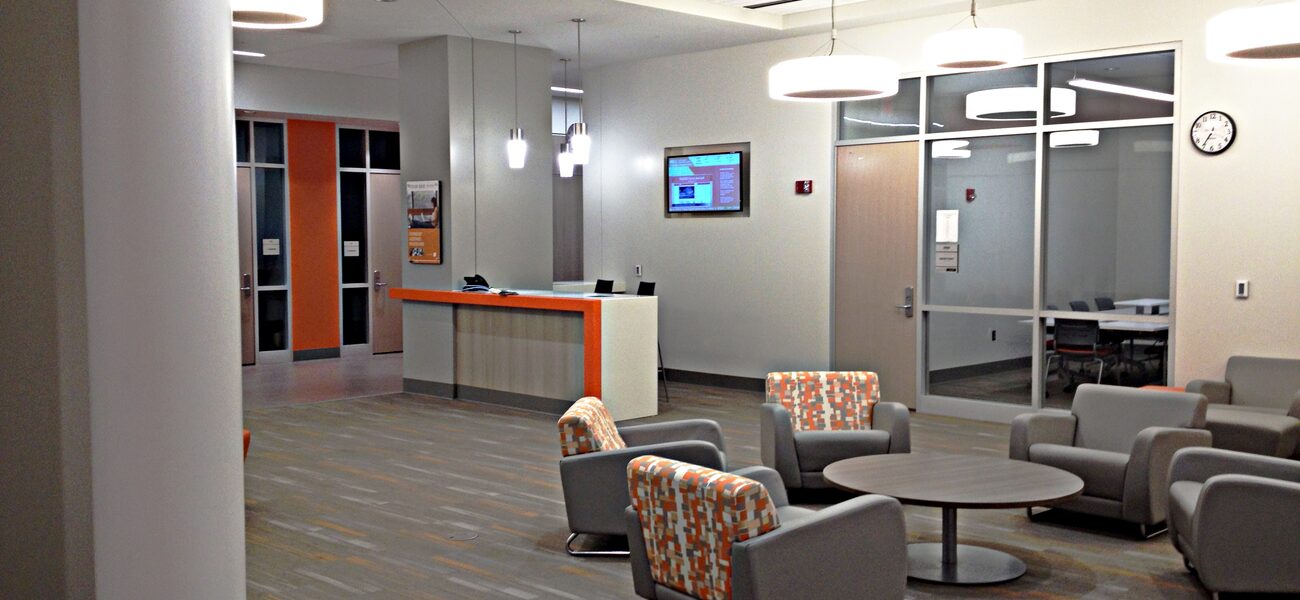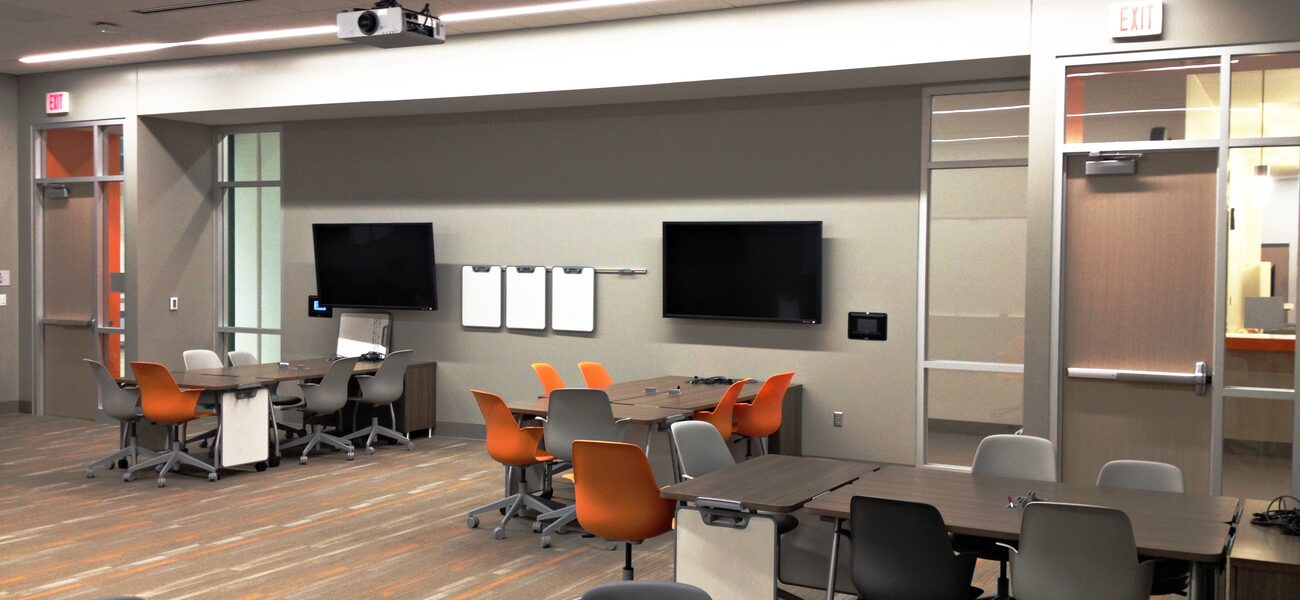These are trying times for public higher education. Scarce capital funding, changing student demographics, missed enrollment targets, hundreds of millions of dollars in deferred maintenance, combined with the academic shift to active learning—all these factors, and more, suggest the need to rethink the traditional residential campus. Bowling Green State University (BGSU) has taken a wide-ranging look at the physical form and mode of operation of its campus, with an eye on more productive asset utilization and greater design flexibility. Its phased, multi-year plan has entailed demolition, renovation and adaptive reuse, and new construction. The plan also reflects a new vision of shared spaces that allow the school to do more with less, implemented by minimizing or eliminating single-use spaces, designing versatile classrooms that accommodate a variety of programs, creating multipurpose buildings that welcome a wide portion of the student body, and expanding the scheduling window.
[See related report on Iowa State University’s move to shared and multi-use spaces]
“The disruption going on in higher education has forced us to think about how we can do more with less—without sacrificing capacity, and, if anything, improving the quality of the output,” says Matthew Cotton, principal, The S/L/A/M Collaborative. “The idea is to get more productivity out of spaces at the room level, at the floorplate, at the building level, and also at the campus level.”
Densifying the Academic Core
Established in 1910 on 1,500 acres half an hour south of Toledo, Ohio, BGSU’s main campus serves roughly 17,000 students. It comprises a mix of 130 buildings, some of original vintage, with “good structure and good bones,” and several others put up during the funding boom of the 1960s and 1970s, with shorter lifespans.
A master plan study undertaken in 2009 revealed that it would take an investment of between $500 million and $1 billion to clear the university’s deferred maintenance backlog, bring all buildings up to design specifications, and accommodate future needs.
“Like most master plans, it identified a much greater intensity of remediation and growth than there was money,” says Cotton.
The findings highlighted the need to establish new priorities and develop a sustainability strategy for the future, sparking a detailed and complex reevaluation of the university’s overall footprint. Planning discussions led to the decision to downsize the campus while increasing density at its core.
“We had a two-pronged focus,” says Dr. Bruce A. Meyer, BGSU assistant vice president, campus operations. “First, looking at the campus footprint and deciding where the core should be to increase collaboration and interaction. The other consideration was utilization, by readjusting class size, evening out scheduling, and avoiding single-use spaces wherever we could.”
Acknowledging that it was impossible to accomplish the full scope of upgrades identified, the master plan targeted six underutilized buildings for demolition. The selections were based primarily on three metrics weighted by their importance to the teaching platform: the number of classrooms in a building, the percentage of the overall classroom inventory that number represents, and the facility condition index.
“It’s very unusual for a university to get rid of a building it owns,” says Cotton. However, the designated targets had high maintenance costs and did not lend themselves to renovation.
This decision allowed BGSU to concentrate its focus on four buildings in the academic core of the campus that touched the largest number of students—and thus offered the largest payback. Even though three of the buildings date back to the university’s earliest days and “were woefully unsuited” for today’s pedagogy, “we found a way to turn them into strategic productive assets,” says Cotton.
What Changed?
Starting in 2012, BGSU moved forward with plans for a $125 million investment in sharable resources at the campus core, implementing these key changes:
- The 1910 multipurpose science building was gut-renovated into a multidisciplinary science facility with flexible classrooms that can support teaching in a variety of subjects. It now features eight flexible teaching labs, two specialty labs, and a 64-station chemistry lab. “Changing nothing but the furniture allows the same space to swing from a teaching lab one semester to an active learning classroom the next, according to scheduling needs, with no changes in infrastructure,” says Cotton.
- University Hall, the first to be constructed on campus, has been revamped into a student services building that now houses Admissions; consolidates and improves access to strategic student services; and centralizes new state-of-the-art active learning classrooms, including four classrooms with 60 to 70 seats, two seminar rooms with 12 seats each, one classroom with 35 seats, and one larger room with 85 to 90 seats.
- A 45,000-sf addition more than doubled the size of 1915 Hanna Hall, creating a gateway building for the College of Business Administration (CBA) at the entrance to the academic core. This building co-locates faculty, CBA student activities, and support services, and extends the teaching platform with three flexible classroom/labs, two active learning classrooms, two high technology teaching labs for simulation, and an analytics and visualization lab.
- The School of Media and Communications, one of the university’s strategic emerging programs, was moved into a 1940s-vintage building refurbished to provide shared classrooms and labs and an enlarged broadcasting studio.
No Single-Use Spaces
All four structures are interconnected, allowing disciplines and students to flow easily from one building to another. For example, students in the business school’s marketing department can use the computer and graphics labs in the adjacent media building. Similarly, other resources are shared across the broader campus, turning the newly densified core into a hive of activity, as exemplified by a dramatic increase in sidewalk traffic.
“There are people everywhere now,” says Meyer.
The new interiors break from the tradition of double-loaded corridors and single-use spaces like classrooms and offices. Following the model of concentric rings of dedicated, flexible, and shared spaces, the layouts instead reflect a pedagogical emphasis on collaboration, interaction, and faculty presence.
“We created platforms that are as interchangeable and synergistic as possible,” says Cotton. “Every space that is available has as many uses as possible and gets the greatest utilization.”
Physically, this translates into neighborhoods of mixed-use floorplates with formal and informal teaching spaces. The CBA building was intentionally designed with a low number of classrooms and smaller faculty offices (90 sf) in favor of more space for collaboration at all levels. Several features promote a sense of community and engagement for all building users, including glass on faculty offices, which are no longer in isolated zones; easily visible collaboration spaces; break-out rooms adjacent to classrooms; and the availability of food and coffee in multiple places. New state-of-the-art active learning classrooms in the connected, upgraded buildings supplement dedicated classrooms in the College of Business Administration building.
Rigorous Scheduling Grid
To arrive at these new configurations, the planning team had drilled down into the actual number of classrooms required to support the campus curriculum.
“In 2012, BGSU had 192 classrooms scheduled,” says Cotton. “We worked with the deans, who were willing to change the way they think about scheduling and came up with a target of 120 classrooms that could essentially provide the same number of hours.”
Managed by a central registrar, rather than by departments, the revised scheduling grid eliminates peaks and valleys, encompassing 12 hours a day Monday through Thursday and eight hours on Friday. Many universities do not follow this rigorous model, Cotton notes, but the promise of a more interactive, collaborative academic environment and new classrooms designed for active learning incentivized acceptance of this major change.
“Faculty understood that level scheduling of course sections through the extended day would enable the university to provide a higher quality teaching environment with better classrooms,” he explains.
Downsized Residence Halls
Roughly 30 percent of BGSU students reside on the campus. Here, too, the university applied its “fewer but better” approach. With strong housing availability in the surrounding community, the university downsized its bed total from 7,600 (many of which were unfilled) to 6,000. In response to changing demographics and student expectations, two older residence halls were taken offline, and two new ones were constructed. In addition, all dining facilities were moved into standalone operations to reduce costs.
Between 600 and 700 of the 2,000 new beds are in townhouse structures designated for fraternities and sororities. Unlike other schools that have seen a waning of the Greek system, BGSU has approximately 40 active chapters that are committed to remaining a part of campus life.
Outcome
Since 2012, in addition to new classrooms in renovated and new buildings, BGSU has renovated approximately 80 classrooms based on the design guidelines established during the master planning process—well on its way to its goal of a 100 percent active learning teaching platform.
“We always thought we needed more classrooms, but we found that what we really needed was to maximize the space,” says Meyer.
Feedback from a plan-test-learn cycle has led to some fine-tuning, but the overall response from both faculty and students has been very positive. Communication among all groups has increased, and the state-of-the-art learning spaces reinforce how highly academics are valued on campus.
“We are seeing two big benefits: better retention numbers and lower daily service costs from an operations standpoint,” says Meyer. “We are scheduling 145 classrooms next fall, and, with the progress that is being made, there is every reason to believe that we are headed toward our target of 120.”
By Nicole Zaro Stahl


